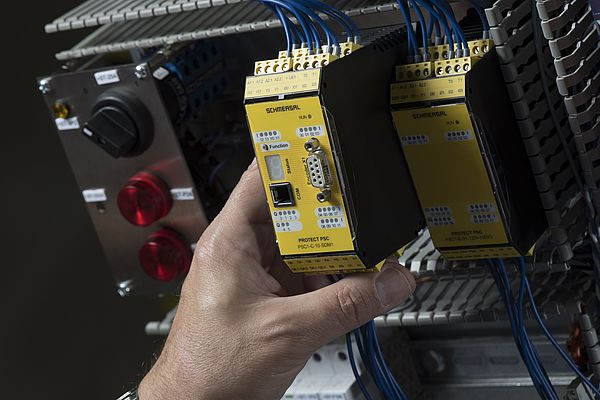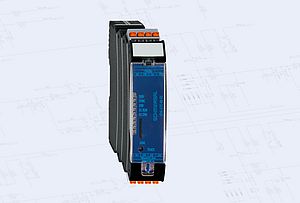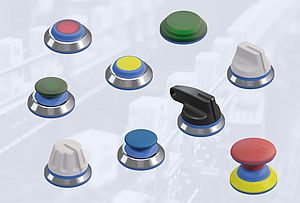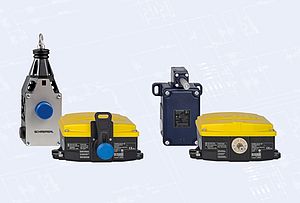Data is the new gold in Industry 4.0 / Industrial Internet of Things. Machines, tools and workpieces will become cyber-physical systems which collect and exchange data. The result is a whole new quality of production data which enables decentralised production control in real-time. The future looks very promising: intelligent workpieces, machines and transport systems should be able to make autonomous “decisions” as to whether a subsequent production stage should be delayed or if another welding robot should take over in the event that one fails, for example.
Converting production systems or machines to manufacture different product variants should also be possible on an automated basis in Industry 4.0. This enables companies a cost-effective production of customer-specific products in very small batch sizes. As a consequence, safety technology also has to be more flexible, individual and cost-effective in future. It also needs to offer a higher level of diagnostic information to allow companies to, for example, increase productivity and enable predictive maintenance and thus improve plant availability. And especially with the new, independent production systems, safety technology must, above all else, protect employees from injuries.
Focus on safety
For the safe signal evaluation, safety technology provider Schmersal provides solutions based on safety relay modules and safety controllers with a wide range of visualisation and diagnostic options depending on the level of complexity and connection depth of the safety circuits. For smaller machines, for example, with one safety door plus emergency stop function, the safety relay module is the most cost-effective solution. The multifunctional relay modules in the Protect SRB-E range perform equally well in a wide range of applications. Each module has multiple functions, so the customer can simply select the application or function they require. No programming experience or software tools are required.
The Protect Select safety controller is suitable for more complex safety-related functions. It has simple menu navigation through the clear text display which allows adaptation to the individual application. The user can select from four application programs which are pre-defined for the most common configurations of safety areas and cover around 80 percent of all applications. This should reduce the configuration required to a minimum without compromising on flexibility. For each program, the user has the option of simply activating functions such as the free allocation of feedback circuits (EDM), startup testing, cyclical testing, auto-start, etc.
Fast-moving sales markets demand cost-effective production of customer-specific products in very small batch sizes. In order to be able to produce smaller batch sizes, modular plants will play a more important role in future. Control functions are distributed across smaller, decentralised units which are networked to one another. Here, the new, modular safety controllers in the PSC product range from Schmersal offer the option of programming individual safety systems. Safe cross-communication is also possible across different PSC controllers thanks to Ethernet Safety Device to Device Communication (SDDC). This simplifies the design of complex, multi-part plants with interconnected safety sub-systems.
With the integrated universal communication interface the user can simply select and configure various fieldbus protocols by using the software. The standard bus systems also make it possible to forward additional non-safe diagnostic signals from the sensors and safety controller to an automation controller. This allows, for example, signals to be evaluated which are relevant to avoiding downtimes or increasing plant availability.
Safety pre-installed
Another option for safeguarding more complex plants and transferring non-secure diagnostics data at the same time is the safety installation systems from Schmersal. The safety switches are not connected directly to safety controllers or safety relay modules, but simply connected in series via distributor modules.
The passive installation systems can also be fitted with an optional “Serial Diagnosis” (SD) interface for the transfer of non-safe status data. Safety sensors and interlocks connected in series and fitted with an SD interface can transfer extensive diagnostics data via the SD gateway and a fieldbus to a controller, e.g. status data or error messages.
For example, in the MZM100-SD contactless solenoid interlock this could, for example, be error messages, such as "Fault or short at a safety output", "Operating voltage too low", or "Defective actuator” to enable rapid error resolution. At the same time, these extended diagnostic functions will, in future, allow predictive maintenance and the avoidance of maintenance, for example, by forwarding non-safety-related status information to the operational controller, for example, an instruction to readjust the safety door if the door is out of alignment.
Virtual cage for robots
Robots will increasingly be used in the digitally networked industry of tomorrow. Cooperation between humans and robots without separating safety fences is one of the hot topics in industrial automation. Schmersal has developed safety controllers for monitoring robots. The safety controller forms the basis for customer-specific solutions. The key features include the automated monitoring of axle position and speed and hazardous movements. If the forces and speeds are low enough, and all the axles are kept in a virtual cage, the robot or machine arm can interact directly with the human. With this development, Schmersal has laid the foundations for some of the newer safety concepts without safety fences which are already in use today.
In order to press ahead with innovation in this future-oriented area, Schmersal is supporting a three-year research project by the Bonn-Rhein-Sieg University of Applied Sciences. The aim of the “beyondSPAI” project is to improve safety in collaboration between humans and robots. Using multi-level sensor systems and intelligent software, the aim is that industrial robots should be able to detect whether there is a person in their movement range or simply an object. Optical sensors and special process image processing algorithms are used in order to recognise human skin and process this data further. As soon as the robot recognises human skin, it “knows” that the situation is different. Put the other way, this means that if it is only an object moving into the movement range of the robot, a stop to the robot movements is not automatically triggered. This means users can achieve increased productivity and plant availability.
Author: Christian Heller, Head of Product Management, Schmersal Group





















